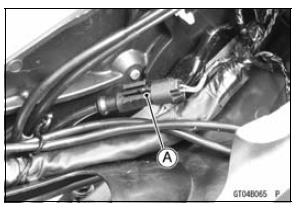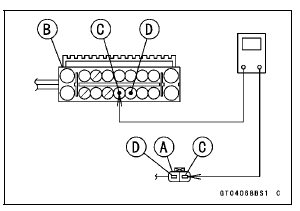


Rear Wheel Rotation Sensor Lead Connector [A] KIBS Hydraulic Unit Lead Connector [B] G Lead Terminals [C] R Lead terminals [D]

If the wiring is open, replace or repair the harness (see KIBS System Circuit in the Brakes chapter).
If the wiring is good, go to next step.
If this service code appears even if all checks are ended, replace the rear wheel rotation sensor (see Rear Wheel Rotation Sensor Removal in the Brakes chapter).
If the service code does not appear, the KIBS system normal (temporary failure).
 Rear Wheel Rotation Sensor Signal Abnormal (Service Code b 44)
Rear Wheel Rotation Sensor Signal Abnormal (Service Code b 44) Power Supply Voltage Inspection (Low-Voltage) (Service Code b 52)
Power Supply Voltage Inspection (Low-Voltage) (Service Code b 52)Lighting System
This motorcycle adopt the daylight system and have a
headlight relay in the relay box. The headlight does not
go on when the ignition switch and the engine stop switch
are first turned on. The headlight comes on after the starter
button is released and stays on until the ignition switch is
turn ...
Catalytic Converter
This motorcycle is equipped with a
catalytic converter in the exhaust system.
The converter reacts with carbonmonoxide,
hydrocarbons and nitrogen
oxides to convert them into carbon
dioxide, water, nitrogen and oxygen resulting
in much cleaner exhaust gases
to be discharged into the atmosphe ...
Fuel Injector Output Voltage Inspection
NOTE
Be sure the battery is fully charged.
Turn the ignition switch to OFF.
Remove the ECU (see ECU Removal).
Do not disconnect the ECU connector
Connect a digital meter [A] to the connector (gray) [B] with
the needle adapter set.
Special Tool - Needle Adapter Set: 57001-1457
...